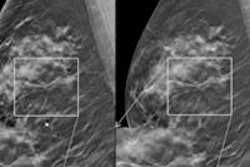Adding one-view digital breast tomosynthesis to screening with conventional digital mammography improves diagnostic accuracy and reduces recall rates -- and adding two-view tomo increases the benefit even further, according to a new study in the February issue of the American Journal of Roentgenology.
Although tomosynthesis is being more widely adopted into clinical practice, it's still unclear how best to incorporate the technology into screening protocols, according to researchers from Massachusetts General Hospital. Lead author Dr. Elizabeth Rafferty and colleagues analyzed two methods of combining tomosynthesis and digital mammography and compared them with digital mammography alone, assessing diagnostic accuracy and recall rates with the addition of one-view and two-view tomosynthesis images (AJR, February 2014, Vol. 202:2, pp. 273-281).
The study included 310 cases, of which there were 51 biopsy-proven malignancies, 47 biopsy-proven benign findings, 138 recalled screening cases, and 74 negative screening cases. Fifteen radiologists received two days of training on interpreting tomosynthesis images, which included the evaluation of 150 exams; none of the training cases were included in the study.
The radiologists reviewed each case sequentially using digital mammography first, followed by one-view tomosynthesis (mediolateral oblique) and two-view tomosynthesis (mediolateral and craniocaudal). They assessed each case for recall and assigned a BI-RADS score and probability of malignancy for each imaging method. Diagnostic accuracy was measured using receiver operator characteristics (ROC) analysis, and screening recall rates were compared using pooled logistical regression analysis.
The area under the ROC curve (AUC) for digital mammography was 0.828, compared with 0.864 for digital mammography plus one-view tomosynthesis and 0.895 for digital mammography plus two-view tomosynthesis, the researchers found. Both one-view and two-view tomosynthesis plus digital mammography performed significantly better than digital mammography alone.
Average recall rates for digital mammography, digital mammography plus one-view tomosynthesis, and digital mammography plus two-view tomosynthesis were 44.2%, 27.2%, and 24.0%, respectively. When combined with digital mammography, one-view and two-view tomosynthesis both showed significantly lower recall rates than digital mammography alone, and digital mammography with two-view tomosynthesis had a significantly lower recall rate than digital mammography with one-view tomosynthesis.
Diagnostic accuracy for dense and nondense breasts improved with digital mammography plus two-view tomosynthesis, compared with digital mammography alone. In addition, diagnostic sensitivity for invasive cancers increased with the addition of both one-view and two-view tomosynthesis, Rafferty and colleagues found.
The study sheds light on the optimal configuration of mammographic-tomosynthesis imaging, they wrote.
"An approach combining two-view tomosynthesis with digital mammography should be the model adopted in clinical practice," the authors concluded.




















